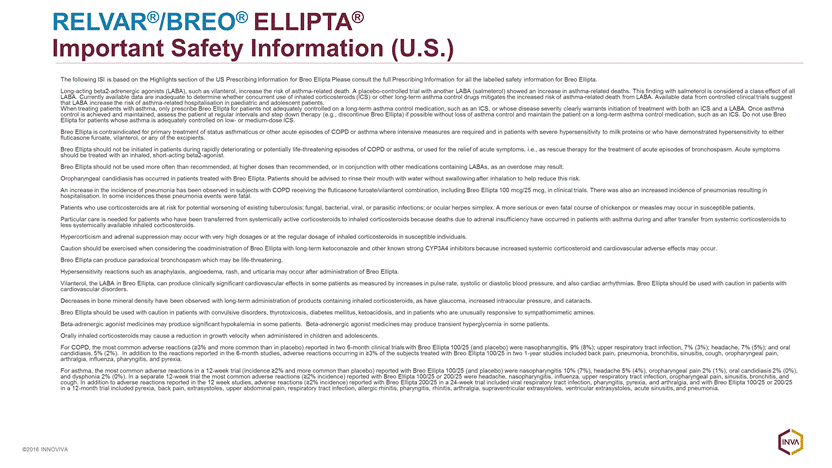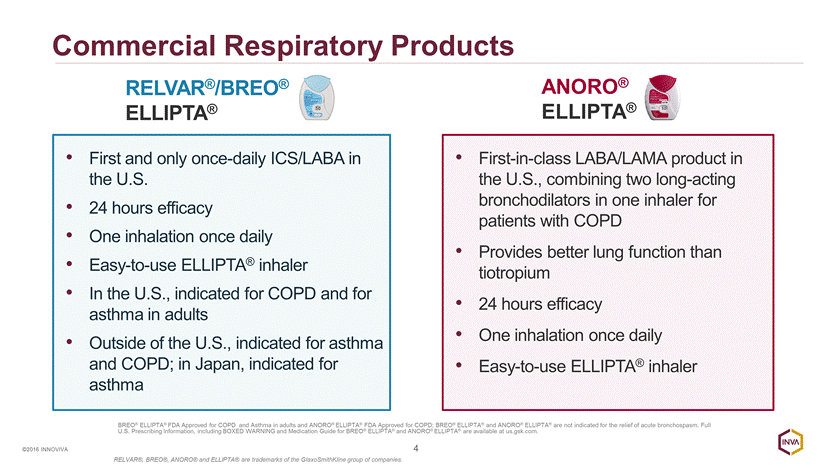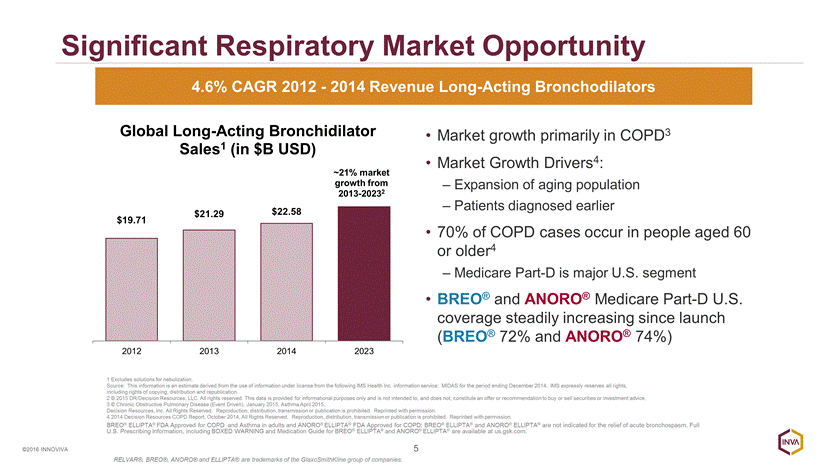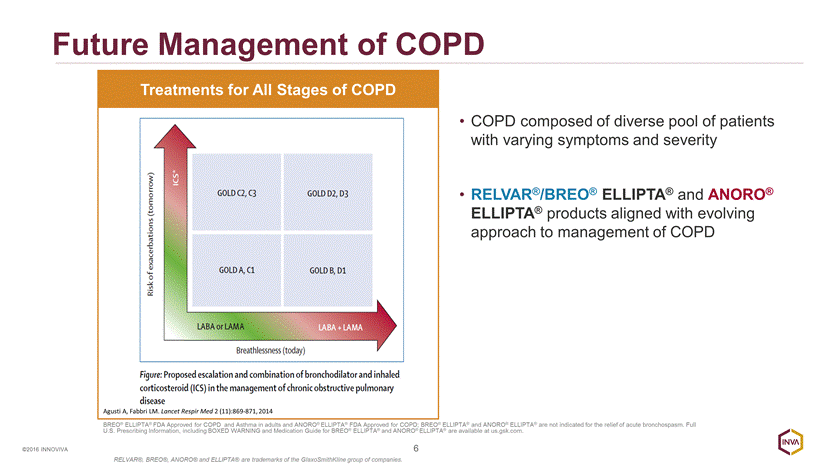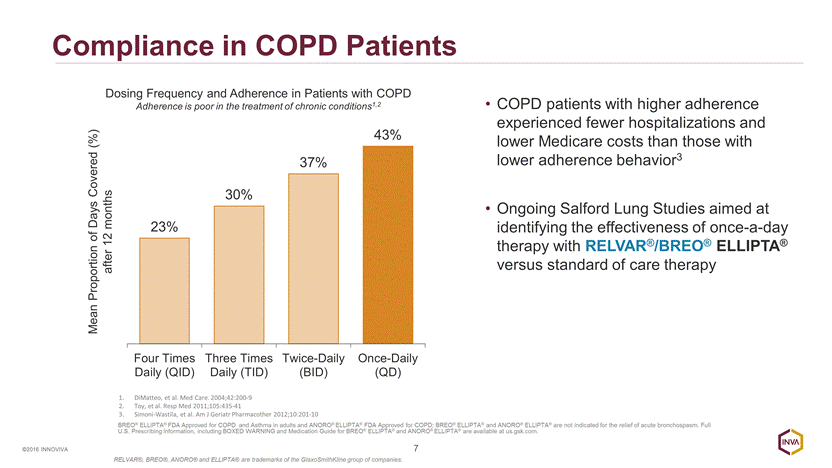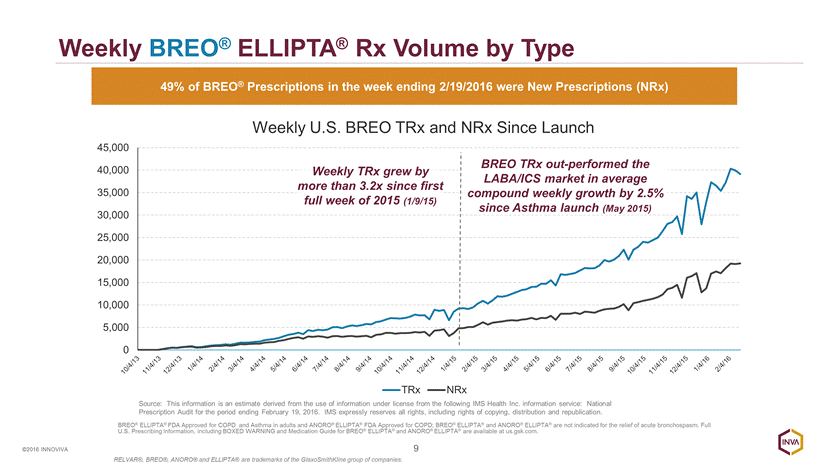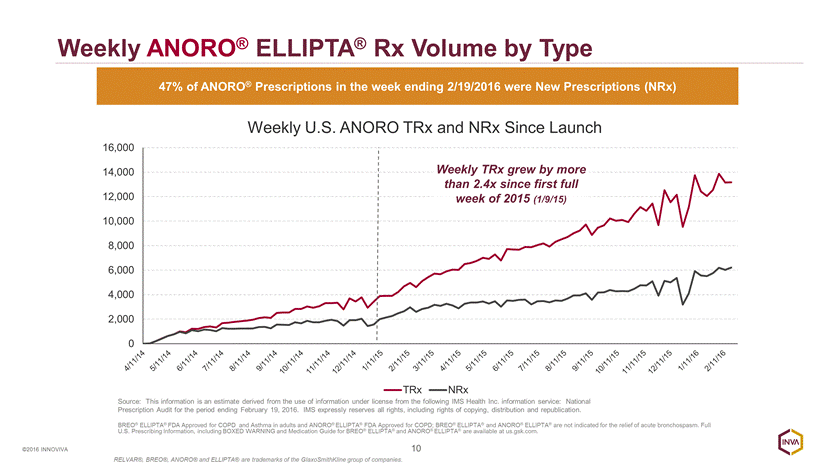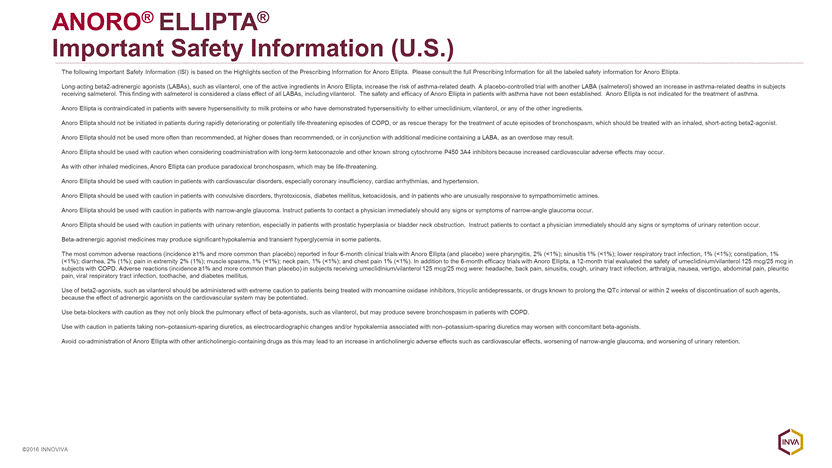RELVAR®/BREO® ELLIPTA® Important Safety Information (U.S.) The following ISI is based on the Highlights section of the US Prescribing Information for Breo Ellipta Please consult the full Prescribing Information for all the labelled safety information for Breo Ellipta. Long-acting beta2-adrenergic agonists (LABA), such as vilanterol, increase the risk of asthma-related death. A placebo-controlled trial with another LABA (salmeterol) showed an increase in asthma-related deaths. This finding with salmeterol is considered a class effect of all LABA. Currently available data are inadequate to determine whether concurrent use of inhaled corticosteroids (ICS) or other long-term asthma control drugs mitigates the increased risk of asthma-related death from LABA. Available data from controlled clinical trials suggest that LABA increase the risk of asthma-related hospitalisation in paediatric and adolescent patients. When treating patients with asthma, only prescribe Breo Ellipta for patients not adequately controlled on a long-term asthma control medication, such as an ICS, or whose disease severity clearly warrants initiation of treatment with both an ICS and a LABA. Once asthma control is achieved and maintained, assess the patient at regular intervals and step down therapy (e.g., discontinue Breo Ellipta) if possible without loss of asthma control and maintain the patient on a long-term asthma control medication, such as an ICS. Do not use Breo Ellipta for patients whose asthma is adequately controlled on low- or medium-dose ICS. Breo Ellipta is contraindicated for primary treatment of status asthmaticus or other acute episodes of COPD or asthma where intensive measures are required and in patients with severe hypersensitivity to milk proteins or who have demonstrated hypersensitivity to either fluticasone furoate, vilanterol, or any of the excipients. Breo Ellipta should not be initiated in patients during rapidly deteriorating or potentially life-threatening episodes of COPD or asthma, or used for the relief of acute symptoms, i.e., as rescue therapy for the treatment of acute episodes of bronchospasm. Acute symptoms should be treated with an inhaled, short-acting beta2-agonist. Breo Ellipta should not be used more often than recommended, at higher doses than recommended, or in conjunction with other medications containing LABAs, as an overdose may result. Oropharyngeal candidiasis has occurred in patients treated with Breo Ellipta. Patients should be advised to rinse their mouth with water without swallowing after inhalation to help reduce this risk. An increase in the incidence of pneumonia has been observed in subjects with COPD receiving the fluticasone furoate/vilanterol combination, including Breo Ellipta 100 mcg/25 mcg, in clinical trials. There was also an increased incidence of pneumonias resulting in hospitalisation. In some incidences these pneumonia events were fatal. Patients who use corticosteroids are at risk for potential worsening of existing tuberculosis; fungal, bacterial, viral, or parasitic infections; or ocular herpes simplex. A more serious or even fatal course of chickenpox or measles may occur in susceptible patients. Particular care is needed for patients who have been transferred from systemically active corticosteroids to inhaled corticosteroids because deaths due to adrenal insufficiency have occurred in patients with asthma during and after transfer from systemic corticosteroids to less systemically available inhaled corticosteroids. Hypercorticism and adrenal suppression may occur with very high dosages or at the regular dosage of inhaled corticosteroids in susceptible individuals. Caution should be exercised when considering the coadministration of Breo Ellipta with long-term ketoconazole and other known strong CYP3A4 inhibitors because increased systemic corticosteroid and cardiovascular adverse effects may occur. Breo Ellipta can produce paradoxical bronchospasm which may be life-threatening. Hypersensitivity reactions such as anaphylaxis, angioedema, rash, and urticaria may occur after administration of Breo Ellipta. Vilanterol, the LABA in Breo Ellipta, can produce clinically significant cardiovascular effects in some patients as measured by increases in pulse rate, systolic or diastolic blood pressure, and also cardiac arrhythmias. Breo Ellipta should be used with caution in patients with cardiovascular disorders. Decreases in bone mineral density have been observed with long-term administration of products containing inhaled corticosteroids, as have glaucoma, increased intraocular pressure, and cataracts. Breo Ellipta should be used with caution in patients with convulsive disorders, thyrotoxicosis, diabetes mellitus, ketoacidosis, and in patients who are unusually responsive to sympathomimetic amines. Beta-adrenergic agonist medicines may produce significant hypokalemia in some patients. Beta-adrenergic agonist medicines may produce transient hyperglycemia in some patients. Orally inhaled corticosteroids may cause a reduction in growth velocity when administered in children and adolescents. For COPD, the most common adverse reactions (>3% and more common than in placebo) reported in two 6-month clinical trials with Breo Ellipta 100/25 (and placebo) were nasopharyngitis, 9% (8%); upper respiratory tract infection, 7% (3%); headache, 7% (5%); and oral candidiasis, 5% (2%). In addition to the reactions reported in the 6-month studies, adverse reactions occurring in >3% of the subjects treated with Breo Ellipta 100/25 in two 1-year studies included back pain, pneumonia, bronchitis, sinusitis, cough, oropharyngeal pain, arthralgia, influenza, pharyngitis, and pyrexia. For asthma, the most common adverse reactions in a 12-week trial (incidence >2% and more common than placebo) reported with Breo Ellipta 100/25 (and placebo) were nasopharyngitis 10% (7%), headache 5% (4%), oropharyngeal pain 2% (1%), oral candidiasis 2% (0%), and dysphonia 2% (0%). In a separate 12-week trial the most common adverse reactions (>2% incidence) reported with Breo Ellipta 100/25 or 200/25 were headache, nasopharyngitis, influenza, upper respiratory tract infection, oropharyngeal pain, sinusitis, bronchitis, and cough. In addition to adverse reactions reported in the 12 week studies, adverse reactions (>2% incidence) reported with Breo Ellipta 200/25 in a 24-week trial included viral respiratory tract infection, pharyngitis, pyrexia, and arthralgia, and with Breo Ellipta 100/25 or 200/25 in a 12-month trial included pyrexia, back pain, extrasystoles, upper abdominal pain, respiratory tract infection, allergic rhinitis, pharyngitis, rhinitis, arthralgia, supraventricular extrasystoles, ventricular extrasystoles, acute sinusitis, and pneumonia. ©2016 INNOVIVA
